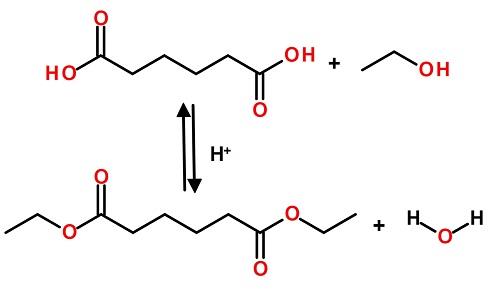Dimethyl adipate 627-93-0
Dimethyl Adipate (DMA) is a colorless, flammable liquid. Soluble in ethanol and ether, slightly soluble in water. DMA is incompatible with strong oxidizing agents and upon decomposition releases carbon monoxide, irritating toxic fumes and gases, and carbon dioxide. DMA reacts with acids, bases and strong oxidizing agents. DMA is synthesized by esterification of adipate. DMA is part of a dibasic ester (DBE) blend used as the main ingredient in many paint strippers, and the DBE blends used in paint stripping formulations contain a majority (approximately 90%) of DMA. DMA is used as chemical intermediates (polymers, agrochemicals), cellulose resins, specialty solvents (inks, coatings, adhesives) and emollients, as well as paint strippers and plasticizers.
| describe | Dimethyl Adipate (DMA) is a colorless, flammable liquid. Soluble in ethanol and ether, slightly soluble in water. DMA is incompatible with strong oxidizing agents and upon decomposition releases carbon monoxide, irritating toxic fumes and gases, and carbon dioxide. DMA reacts with acids, bases and strong oxidizing agents. DMA is synthesized by esterification of adipate. DMA is part of a dibasic ester (DBE) blend used as the main ingredient in many paint strippers, and the DBE blends used in paint stripping formulations contain a majority (approximately 90%) of DMA. DMA is used as chemical intermediates (polymers, agrochemicals), cellulose resins, specialty solvents (inks, coatings, adhesives) and emollients, as well as paint strippers and plasticizers. |
| chemical properties | Dimethyl adipate is a colorless liquid. It is a fatty acid methyl ester. |
| use | Dimethyl adipate is used in cosmetics (emollients and skin conditioners). Used as a plasticizer and finishing agent for cellulosic resins. It is also used in agrochemicals and dyes and as a precursor in the preparation of active pharmaceutical ingredients. Additionally, it is used as a polymer intermediate. In addition to this, it is also used as a solvent for paint strippers and resins. |
| use | Dimethyl adipate is used in cosmetics (emollients and skin conditioners). It acts as a cosmetic plasticizer. It is also used in agrochemicals and dyes and in the preparation of precursors for active pharmaceutical ingredients. Additionally, it is used as a polymer intermediate. In addition to this, it is also used as a solvent for paint strippers and resins. |
| definition | ChEBI: Dimethyl adipate is a fatty acid methyl ester. |
| production method | Dimethyl adipate is produced by the esterification of adipic acid and methanol in the presence of an acid catalyst. |
| general instructions | colorless liquid. |
| air and water reaction | Flammable. Hydrolyzed by strong mineral acids and strong bases. |
| reactive profile | Dimethyl adipate is an ester. The ester reacts with the acid, releasing heat along with the alcohol and acid. Strong oxidizing acids may cause a violent reaction that is sufficiently exothermic to ignite the reaction products. The interaction of the ester with the caustic solution also generates heat. Esters mixed with alkali metals and hydrides can produce flammable hydrogen gas. |
| health hazard | May be harmful if inhaled, ingested or absorbed through the skin. May cause irritation. |
| health hazard | Exposure to dimethyl adipate can cause toxicity and adverse health effects in laboratory animals and humans. Exposure to dimethyl adipate in the workplace through inhalation, ingestion, or skin absorption can cause harmful and irritating effects to users. |
| Flammability and explosiveness | non-flammable |
| Security overview | The intraperitoneal route is moderately toxic. Experimental teratogenic and reproductive effects. When heated and decomposed, acrid and irritating fumes are released. |
| synthesis | Dimethyl adipate was synthesized by the esterification reaction of adipic acid and methanol catalyzed by immobilized Candida antarctica lipase B.  Dimethyl adipate was synthesized from adipic acid (730 mg, 5 mmol) and methanol (10 ml) according to the general procedure described above. Yield: 9%. 1H NMR (400.1 MHz, CDCl3): δ = 3.56 (6H, s, H1-H10), 2.23 (4H, m, H4-H7), 1.56 (4H, m, H5-H6). 13C NMR (100.5 MHz, CDCl3): δ = 173.4 (C3-C8), 51.2 (C1-C10), 33.4 (C4-C7), 24.1 (C5-C6) https://pubmed.ncbi.nlm.nih . government/20632329/ |
| Carcinogenicity | In a chronic inhalation toxicity study of dimethyl adipate, groups of male and female rats were exposed to 400 mg/m of dimethyl adipate over a 90-day period . Focal respiratory metaplasia of the olfactory epithelium was found. The severity of these nonneoplastic lesions ranged from mild to minor. |
| Precautions | When handling dimethyl adipate, occupational workers should be careful and use self-contained breathing apparatus, rubber boots and thick rubber gloves, and avoid prolonged contact. Workers should avoid skin, eye and nose contact with dimethyl adipate. |
| Dimethyl adipate upstream and downstream product information |
| raw material | Adipic acid --> Monomethyl adipate --> Dimethyl ethyl succinate --> Dimethyl (1E , 3E)-1,3-butadiene-1,4-dicarboxylate-- > Semialdehyde methyl adipate --> D-glucaric acid- -> D-glucaric acid 1,4:6,3-diolactone --> Dimethyl 2-methylglutaric acid-- > Homocitrate-γ-lactone --> Dimethyl glutarate--> 6-Oxohexanoic acid--> Dimethyl sebacate --> Dimethyl pentadecanedioate --> Dimethyl undecanedioate |
| Preparation products | 3-Ethyl-2-hydroxy-2-cyclopenten-1-one --> 6-hydroxycaproic acid |








